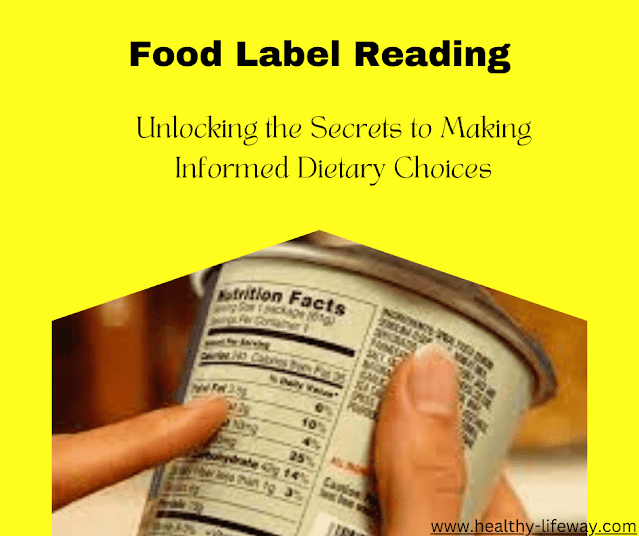Food Label Reading
 |
| Food Label Reading |
Food Label Reading
Unlocking the Secrets to Making Informed Dietary Choices
Introduction:
In a world abundant with food choices, navigating the aisles of supermarkets can be a bewildering experience. Fortunately, within the packaging of every product lies a hidden treasure trove of information - the food label. As we embark on a journey to unravel the mysteries of food label reading, we equip ourselves with the knowledge to make informed dietary choices that promote health, well-being, and a deeper connection to the food we consume. In this article, we delve into the art of decoding food labels, empowering ourselves to become discerning consumers and guardians of our own nourishment.
The Anatomy of a Food Label
Before embarking on our quest for nutritional enlightenment, let us first decipher the components of a food label. From the serving size to the list of ingredients and the nutrient facts panel, each element plays a significant role in unraveling the story behind the product. Understanding these components forms the foundation of our journey toward informed dietary decisions.
Unmasking Hidden Sugars and Sodium
As we scrutinize the food label, we discover the undercover agents of health concerns - hidden sugars and sodium. Sugar, often concealed under various names, may stealthily creep into our diets, affecting our overall health, including dental well-being and weight management. Similarly, excessive sodium intake can elevate blood pressure and pose risks to cardiovascular health. By learning to identify and limit these additives, we empower ourselves to make wiser choices and prioritize our long-term health.
Grasping Fats: The Good, the Bad, and the Essential
Fats can be both friend and foe in our dietary journey. Learning to distinguish between saturated, trans, monounsaturated, and polyunsaturated fats allows us to favorably impact heart health and manage cholesterol levels. Moreover, understanding the importance of essential fatty acids, such as omega-3 and omega-6, unveils the keys to promoting brain function and overall well-being.
Decoding Nutrient Percentages and Daily Values
The nutrient facts panel can be a treasure map guiding us to make healthier choices. By paying attention to the percentage of daily values, we gain insight into how a particular food item contributes to our daily nutritional requirements. Armed with this knowledge, we can tailor our diets to meet our individual needs and preferences while ensuring a balanced intake of essential nutrients.
The Fine Print: Investigating Food Additives and Allergens
Beyond the obvious components of food labels, the fine print reveals a wealth of valuable information. We delve into the world of food additives, preservatives, and artificial flavors, becoming detectives in deciphering the potential impact of these ingredients on our bodies. Additionally, learning to identify allergens can safeguard the health of individuals with specific sensitivities, promoting inclusivity and well-being.
Embracing Whole and Natural Foods
As we navigate the landscape of food label reading, we find that the most nutritious and wholesome foods often require no labels at all. Embracing whole and natural foods, such as fresh fruits, vegetables, nuts, seeds, and grains, can simplify the process of making health-conscious choices. These unprocessed foods not only provide essential nutrients but also offer a cornucopia of flavors and textures, elevating our culinary experiences and connecting us with the pure essence of nourishment.
Mindful Consumption and Portion Control
Food label reading extends beyond merely understanding the nutritional content; it involves fostering a mindful approach to consumption. By practicing portion control and being mindful of our hunger cues, we cultivate a harmonious relationship with food. Engaging in mindful eating enables us to savor each bite, appreciate the journey from farm to table, and recognize the impact of our dietary choices on both personal well-being and the broader environment.
Empowering the Next Generation
The art of food label reading is a valuable skill that we can impart to future generations. By educating children about the significance of food labels and nurturing their curiosity about nutrition, we equip them with the tools to make informed choices, laying the foundation for a healthier and more mindful society.
Building Bridges Between Food Labels and Sustainable Practices
Beyond the individual benefits, food label reading bridges the gap between consumer choices and sustainable practices. By seeking products with eco-friendly certifications, fair-trade labels, and responsibly sourced ingredients, we become advocates for ethical and sustainable food production. Each conscious decision we make at the grocery store becomes a vote for a better future for both ourselves and the planet.
A Journey of Continuous Learning
As we conclude our exploration of food label reading, let us embrace it as a journey of continuous learning and growth. The world of nutrition is ever-evolving, and by staying informed about the latest research and developments, we can adapt our dietary choices to align with our evolving needs and aspirations.
Conclusion:
The art of food label reading is a transformative voyage that leads us to a deeper understanding of the foods we consume. Armed with this knowledge, we gain the power to make informed dietary choices that nurture our bodies, respect the environment, and foster a connection to the foods we cherish. Let us embark on this path of mindful eating, honoring the wisdom of food labels, and celebrating the abundance of nourishment that enriches our lives.







Post a Comment